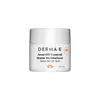What's inside
What's inside
 Key Ingredients
Key Ingredients

 Benefits
Benefits

 Concerns
Concerns

 Ingredients Side-by-side
Ingredients Side-by-side

Salicylic Acid 0.53%
MaskingWater
Skin ConditioningStearic Acid
CleansingCaprylic/Capric Triglyceride
MaskingCetyl Alcohol
EmollientGlyceryl Stearate Citrate
EmollientMelaleuca Alternifolia Leaf Oil
AntioxidantGlycerin
HumectantPolysorbate 60
EmulsifyingSalix Alba Bark Extract
AstringentAniba Rosodora Wood Oil
AstringentSimmondsia Chinensis Seed Oil
EmollientChamomilla Recutita Flower Extract
MaskingAloe Barbadensis Extract
Skin ConditioningAllantoin
Skin ConditioningPanthenol
Skin ConditioningXanthan Gum
EmulsifyingPolysorbate 20
EmulsifyingGlyceryl Stearate
EmollientCetearyl Glucoside
EmulsifyingPotassium Sorbate
PreservativePhenoxyethanol
PreservativeEthylhexylglycerin
Skin ConditioningLavandula Angustifolia Oil
MaskingSalicylic Acid 0.53%, Water, Stearic Acid, Caprylic/Capric Triglyceride, Cetyl Alcohol, Glyceryl Stearate Citrate, Melaleuca Alternifolia Leaf Oil, Glycerin, Polysorbate 60, Salix Alba Bark Extract, Aniba Rosodora Wood Oil, Simmondsia Chinensis Seed Oil, Chamomilla Recutita Flower Extract, Aloe Barbadensis Extract, Allantoin, Panthenol, Xanthan Gum, Polysorbate 20, Glyceryl Stearate, Cetearyl Glucoside, Potassium Sorbate, Phenoxyethanol, Ethylhexylglycerin, Lavandula Angustifolia Oil
Salicylic Acid 2%
MaskingWater
Skin ConditioningIsododecane
EmollientSodium Polyacrylate
AbsorbentSqualane
EmollientSodium Acrylates Crosspolymer-2
AbsorbentNiacinamide
SmoothingPhenoxyethanol
PreservativeXanthan Gum
EmulsifyingEthylene/Propylene/Styrene Copolymer
Butylene/Ethylene/Styrene Copolymer
Ethylhexylglycerin
Skin ConditioningLavandula Angustifolia Oil
MaskingLinalool
PerfumingCitrus Aurantium Bergamia Fruit Oil
MaskingLimonene
PerfumingTrisodium Ethylenediamine Disuccinate
Silica
AbrasiveCeramide NP
Skin ConditioningGlycerin
HumectantPentaerythrityl Tetra-Di-T-Butyl Hydroxyhydrocinnamate
AntioxidantErythritol
HumectantTocopherol
AntioxidantHibiscus Esculentus Fruit Extract
Skin ConditioningSalicylic Acid 2%, Water, Isododecane, Sodium Polyacrylate, Squalane, Sodium Acrylates Crosspolymer-2, Niacinamide, Phenoxyethanol, Xanthan Gum, Ethylene/Propylene/Styrene Copolymer, Butylene/Ethylene/Styrene Copolymer, Ethylhexylglycerin, Lavandula Angustifolia Oil, Linalool, Citrus Aurantium Bergamia Fruit Oil, Limonene, Trisodium Ethylenediamine Disuccinate, Silica, Ceramide NP, Glycerin, Pentaerythrityl Tetra-Di-T-Butyl Hydroxyhydrocinnamate, Erythritol, Tocopherol, Hibiscus Esculentus Fruit Extract
Ingredients Explained
These ingredients are found in both products.
Ingredients higher up in an ingredient list are typically present in a larger amount.
Ethylhexylglycerin (we can't pronounce this either) is commonly used as a preservative and skin softener. It is derived from glyceryl.
You might see Ethylhexylglycerin often paired with other preservatives such as phenoxyethanol. Ethylhexylglycerin has been found to increase the effectiveness of these other preservatives.
Glycerin is already naturally found in your skin. It helps moisturize and protect your skin.
A study from 2016 found glycerin to be more effective as a humectant than AHAs and hyaluronic acid.
As a humectant, it helps the skin stay hydrated by pulling moisture to your skin. The low molecular weight of glycerin allows it to pull moisture into the deeper layers of your skin.
Hydrated skin improves your skin barrier; Your skin barrier helps protect against irritants and bacteria.
Glycerin has also been found to have antimicrobial and antiviral properties. Due to these properties, glycerin is often used in wound and burn treatments.
In cosmetics, glycerin is usually derived from plants such as soybean or palm. However, it can also be sourced from animals, such as tallow or animal fat.
This ingredient is organic, colorless, odorless, and non-toxic.
Glycerin is the name for this ingredient in American English. British English uses Glycerol/Glycerine.
Learn more about GlycerinLavandula Angustifolia Oil is more commonly known as lavender essential oil. It is considered a fragrancing ingredient.
Lavender imparts a famous scent. While the smell is lovely, this ingredient and may sensitize skin in topical products. This is because about 85% of the oil is made up of linalool and linalyl acetate.
When exposed to air, these two compounds become strong allergens. This ingredient exhibits cytotoxicity at low concentrations; amounts of 0.25% have been shown to damage skin cells.
A study from Japan found this ingredient caused lavender sensitivity after widespread exposure.
Lavender essential oil has some antimicrobial, antibacterial, and anti-inflammatory properties. However, the cons of this ingredient may outweight the pros.
More research is needed to confirm lavender essential oil's effects when used in aromatherapy.
Lavandula Angustifolia is known as the English Lavender and famous for creating purple fields in Provence, France.
Learn more about Lavandula Angustifolia OilPhenoxyethanol is a preservative that has germicide, antimicrobial, and aromatic properties. Studies show that phenoxyethanol can prevent microbial growth. By itself, it has a scent that is similar to that of a rose.
It's often used in formulations along with Caprylyl Glycol to preserve the shelf life of products.
Salicylic Acid (also known as beta hydroxy acid or BHA) is a well-known ingredient for treating skin that struggles with acne and clogged pores. It exfoliates both the skin's surface and deep within the pores to help clear out buildup, control oil, and reduce inflammation.
Unlike AHAs (alpha hydroxy acids), salicylic acid is oil-soluble. This allows it to penetrate into pores which makes it especially effective for treating blackheads and preventing future breakouts.
Salicylic acid is also known for its soothing properties. It has a similar structure to aspirin and can calm inflamed or irritated skin, making it a good option for acne-prone skin that is also sensitive.
Concentrations of 0.5-2% are recognized by the U.S. FDA as an over-the-counter topical acne product.
It can cause irritation and/or dryness if one's skin already has a compromised moisture barrier, so it's best to focus on repairing that before introducing this ingredient into your routine.
While salicylic acid does not increase sun sensitivity, it’s still important to wear sunscreen daily to protect your skin.
If you are looking for the ingredient called BHA or Butylated Hydroxyanisole, click here.
Learn more about Salicylic AcidWater. It's the most common cosmetic ingredient of all. You'll usually see it at the top of ingredient lists, meaning that it makes up the largest part of the product.
So why is it so popular? Water most often acts as a solvent - this means that it helps dissolve other ingredients into the formulation.
You'll also recognize water as that liquid we all need to stay alive. If you see this, drink a glass of water. Stay hydrated!
Learn more about WaterXanthan gum is used as a stabilizer and thickener within cosmetic products. It helps give products a sticky, thick feeling - preventing them from being too runny.
On the technical side of things, xanthan gum is a polysaccharide - a combination consisting of multiple sugar molecules bonded together.
Xanthan gum is a pretty common and great ingredient. It is a natural, non-toxic, non-irritating ingredient that is also commonly used in food products.
Learn more about Xanthan Gum